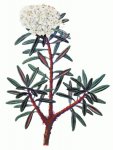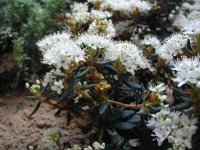Labrador tea marsh - ledum palustre l.
Family Heather - Ericaceae
Botanical characteristics. Ledum is a marsh - an evergreen shrub with a strong aromatic odor.
The root is thin. Stems with rising branches of grayish-rusty color. Leaves are regular, narrow, leathery, dark green on top, bottom - reddish-furred, with slightly wrapped edges. The flowers are small, whitish-pale yellow, collected in a dense inflorescence. Fruit is a drooping box with numerous small seeds. Blooms in May - June, the seeds ripen in July - August.
Spread. It grows in meadows, along peaty sphagnum bogs, among boggy bushes and coniferous forests, often with thickets.
Used parts of the plant. The medicinal raw material is the aboveground part of the plant. Collect shoots during flowering. Seeds - as they mature. Dry in the shade outdoors. The plant is very potent, therefore, care must be taken when collecting and drying the raw materials.
Chemical composition. All parts of the plant contain an essential oil that includes ice cream, cymene, palustrol, pinene, camphene, geranilacetate, fellandren, limonene and their derivatives, bicyclic alcohols and hydrocarbons, glycosides (arbutin and ericoline), flavonoids (quercetin, hyperoside), coumarins (Esketuin, scopoletin, fraksetin, umbelliferon), vitamins and steroids.
Application. Ledum has anti-inflammatory, expectorant, antiseptic properties.
In the experiment, Ledum extracts exert a depressing effect on the cough reflex, expand the peripheral and coronary vessels, increase the amplitude of heartbeats, increase diuresis, which makes it possible to consider them as a promising agent in the treatment of hypertension and confirms the advisability of using pertussis, bronchitis, bronchial asthma, tuberculosis.
In folk medicine infusions and decoctions of leaves and flowers are used for headaches and heart diseases, pulmonary tuberculosis, acute and chronic bronchitis, bronchial asthma, pertussis, enterocolitis; Externally - as compresses and rubs - with myositis, neuritis, joint disease; In the form of ointments - with bruises, frostbite, skin diseases.
Essential oil has a strong anti-inflammatory, anti-exudative effect, causes hypotension, increases blood flow velocity, has a pronounced spasmolytic and moderate stimulating effect, softens convulsions, increases the resistance of stomach tissues, activates the separation of bronchial mucus.
The juice of fresh rosemary plant has antibacterial, phytoncidal and protistocidal properties. Oppressing the development of diphtheria and pertussis rods, some viruses, hemolytic streptococcus, a glowing vibrio.
In Buryatia and Yakutia, lemongrass preparations are used for catarrhal diseases, arthritis of various etiologies, cystitis, female diseases, dysentery, skin diseases, eczema, scabies, insect bites, chicken pox, blepharitis, conjunctivitis, for growth and strengthening of hair.
In Komi, fresh juice is added to wine under alcoholism. In Germany and France, juice is used for various diseases accompanied by cough, angina pectoris, various forms of rheumatism. In Bulgaria, hot infusion of Ledum flower is used for cholecystitis, as an abortifacient.
In homeopathy externally - with rheumatism (Lori alcohol), gout, arthritis, skin diseases, wounds, frostbite, in the treatment of tumors and asthma. ,
The domestic preparation "Ledin", which has an expectorant effect, has been developed. It is used for coughing.
Ledum is a repellent for household insects.
Preparation
- To prepare the infusion, take 6 g of crushed leaves and flowers, pour 180 ml of boiling water, insist on the bath for 15 minutes, cool 45 minutes, filter. Take 2 tbsp. Spoon 3-4 times a day.
- For broth take 10 g of shredded shoots of Ledum, pour boiling water 200 ml, insist on a water bath for 30 minutes, cool 10 minutes, filter, bring to 200 ml. Take 2 tbsp. Spoon 3 times a day after meals.
Contraindications. The plant is weakly toxic, treatment should be carried out under the supervision of a doctor.





Comments
Commenting on, remember that the content and tone of your message can hurt the feelings of real people, show respect and tolerance to your interlocutors even if you do not share their opinion, your behavior in the conditions of freedom of expression and anonymity provided by the Internet, changes Not only virtual, but also the real world. All comments are hidden from the index, spam is controlled.